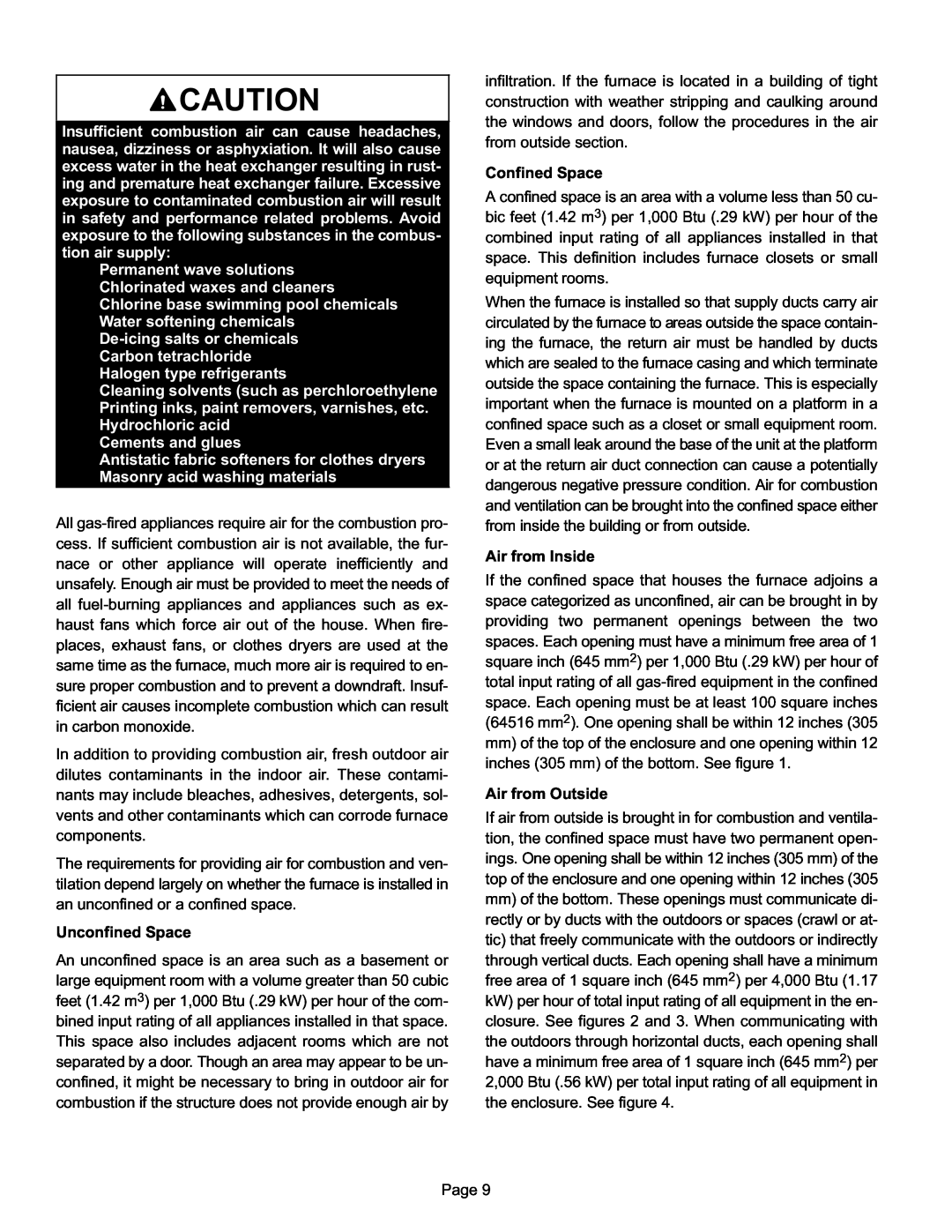
![]() CAUTION
CAUTION
Insufficient combustion air can cause headaches, nausea, dizziness or asphyxiation. It will also cause excess water in the heat exchanger resulting in rust- ing and premature heat exchanger failure. Excessive exposure to contaminated combustion air will result in safety and performance related problems. Avoid exposure to the following substances in the combus- tion air supply:
Permanent wave solutions Chlorinated waxes and cleaners Chlorine base swimming pool chemicals Water softening chemicals
Cleaning solvents (such as perchloroethylene Printing inks, paint removers, varnishes, etc. Hydrochloric acid
Cements and glues
Antistatic fabric softeners for clothes dryers Masonry acid washing materials
All
In addition to providing combustion air, fresh outdoor air dilutes contaminants in the indoor air. These contami- nants may include bleaches, adhesives, detergents, sol- vents and other contaminants which can corrode furnace components.
The requirements for providing air for combustion and ven- tilation depend largely on whether the furnace is installed in an unconfined or a confined space.
Unconfined Space
An unconfined space is an area such as a basement or large equipment room with a volume greater than 50 cubic feet (1.42 m3) per 1,000 Btu (.29 kW) per hour of the com- bined input rating of all appliances installed in that space. This space also includes adjacent rooms which are not separated by a door. Though an area may appear to be un- confined, it might be necessary to bring in outdoor air for combustion if the structure does not provide enough air by
infiltration. If the furnace is located in a building of tight construction with weather stripping and caulking around the windows and doors, follow the procedures in the air from outside section.
Confined Space
A confined space is an area with a volume less than 50 cu- bic feet (1.42 m3) per 1,000 Btu (.29 kW) per hour of the combined input rating of all appliances installed in that space. This definition includes furnace closets or small equipment rooms.
When the furnace is installed so that supply ducts carry air circulated by the furnace to areas outside the space contain- ing the furnace, the return air must be handled by ducts which are sealed to the furnace casing and which terminate outside the space containing the furnace. This is especially important when the furnace is mounted on a platform in a confined space such as a closet or small equipment room. Even a small leak around the base of the unit at the platform or at the return air duct connection can cause a potentially dangerous negative pressure condition. Air for combustion and ventilation can be brought into the confined space either from inside the building or from outside.
Air from Inside
If the confined space that houses the furnace adjoins a space categorized as unconfined, air can be brought in by providing two permanent openings between the two spaces. Each opening must have a minimum free area of 1 square inch (645 mm2) per 1,000 Btu (.29 kW) per hour of total input rating of all gas−fired equipment in the confined space. Each opening must be at least 100 square inches (64516 mm2). One opening shall be within 12 inches (305
mm)of the top of the enclosure and one opening within 12 inches (305 mm) of the bottom. See figure 1.
Air from Outside
If air from outside is brought in for combustion and ventila- tion, the confined space must have two permanent open- ings. One opening shall be within 12 inches (305 mm) of the top of the enclosure and one opening within 12 inches (305
mm)of the bottom. These openings must communicate di- rectly or by ducts with the outdoors or spaces (crawl or at- tic) that freely communicate with the outdoors or indirectly through vertical ducts. Each opening shall have a minimum free area of 1 square inch (645 mm2) per 4,000 Btu (1.17 kW) per hour of total input rating of all equipment in the en- closure. See figures 2 and 3. When communicating with the outdoors through horizontal ducts, each opening shall have a minimum free area of 1 square inch (645 mm2) per 2,000 Btu (.56 kW) per total input rating of all equipment in the enclosure. See figure 4.
Page 9
